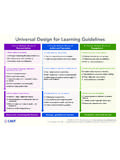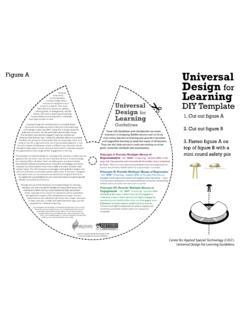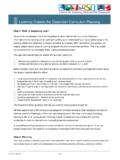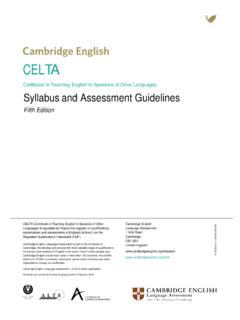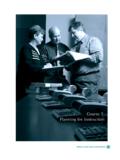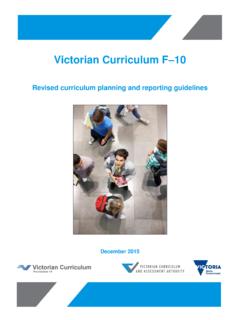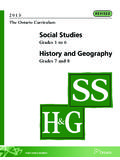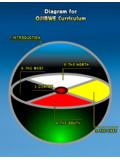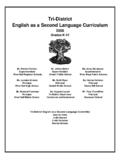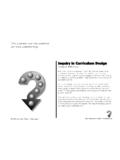Transcription of Curriculum Planning for All Learners - National …
1 Curriculum Planning for All LearnersApplying Universal Design for Learning (UDL) to a High School Reading Comprehension ProgramGrace MeoNational Center on UDL40 Harvard Mills Square, Suite 3 Wakefield, MA 01880-3233 Tel: 781-245-2212 TTY: 781-245-9320 Fax: 781-245-5212 Web: Planning for All LearnersApplying Universal Design for Learning (UDL) to a High School Reading Comprehension ProgramGrace MeoOriginally published as:Meo, G. (2008). Curriculum Planning for all Learners : Applying universal design for learning (UDL) to a high school reading comprehension program. Preventing School Failure, 52(2), 21-30. Table of ContentsA Blueprint For Teaching Every Student: UDL .. 3 Planning For All Learners : Connecting UDL To Curriculum Planning .. 5 Connecting UDL to Classroom Practice..8 Identifying the PAL Team..9 Project Highlights.. 12 Summary.. 13 Acknowledgments .. 13 References.. 14 Apendix A: The Universal Design for Learning (UDL) Goal Setter.
2 17 Apendix B: Additional Resources For Understanding and Applying Universal Design For Learning (UDL) .. 18 Appendix C: Universal Design For Learning (UDL) Planning for All Learners Checklist . 20 Curriculum Planning for All Learners : Applying Universal Design For The universal design for learning (UDL) principles provide a blueprint for designing a Curriculum that addresses the diverse needs of all Learners . The author provides an overview of UDL, connections to Curriculum Planning , and practical techniques that guide general and special education teachers in Planning and implementing Curriculum , using the Planning for all Learners (PAL) procedures. PAL is a 4-step process for designing and implementing a Curriculum (goals, methods, materials, and assessments) that is accessible and effective for all Learners . In this article, the author focuses on high school social studies content with a goal of supporting all students understanding of the content by bringing together principles of UDL, the PAL process, and research-based reading comprehension accessibility, Curriculum Planning and instruction, reading comprehension, secondary school, universal design for learningIn the fall, high school teachers across the nation return to their classrooms with varied expectations and goals.
3 Many are ready to meet the challenges of the new school year that include preparing all students for state-mandated achievement tests and ensuring that students make progress understanding course content. These teachers know the standards as defined by their state and local districts and recognize that they are accountable for all students performance in reaching these standards. Students also approach the new year with diverse expectations. For instance, some are eager to get a fresh start this year and earn good grades. These regular students easily meet their teachers expectations and the district there are special students who reluctantly enter the high school classroom, knowing that failure is the likely result again this year no matter how hard they try. These students encounter many obstacles during each school day, ranging from not being able to read the textbook to having insufficient background knowledge to understand the course content.
4 Their day is filled with barriers that make learning difficult. They must change something about themselves to succeed if only they knew what. These students keep a teacher up at night trying to adapt course content to meet their needs, figuring out how to encourage each one to try harder, or, in some cases, looking for an alternate route that may include both a different Curriculum and a different classroom setting. None of these solutions best serves the diversity of today s student population. Rather, they place incredible burdens on teachers and students alike to adapt to an inflexible, barrier-filled Curriculum . Educators do not seem to question whether the burden of adaptation should fall on the Curriculum itself that the Curriculum , and not the students labeled special, is what needs Planning for All Learners : Applying Universal Design For regular students also struggle to succeed in a one-size-fits-all regular-education Curriculum . However, recent brain research and theories of learning clearly indicate that each learner is special ( , unique), with varied abilities and qualities, and that the typical classroom represents a vast range of learner differences (Meyer & Rose, 2000; Rose & Meyer, 2002).
5 In fact, categorizing students into two groups regular and special oversimplifies learner differences and fails to accurately represent the diversity of today s high school student ensure that all students have genuine opportunities to learn in standards-based settings, educators need to develop a new understanding of learner differences. Whereas learner differences have been traditionally defined as inherent strengths and weaknesses of students themselves (without regard for weaknesses in the Curriculum itself, which has been regarded as static and infallible), the interaction between the learner and the educational Curriculum must be considered (Meyer & Rose, 2005). In other words,in looking for ways to include all Learners in high-quality, standards-based educational settings, educators and researchers should examine ways in which the Curriculum presents barriers and supports to academic achievement by diverse Learners and how the Curriculum can be developed to include all Learners from the framework for addressing the diversity of all students and creating a flexible Curriculum that supports access, participation, and progress for all Learners is universal design for learning (UDL; Meyer & Rose, 2000; Rose & Meyer, 2002).
6 As a framework for creating a flexible Curriculum , which in standards-based settings includes instructional goals, methods, assessments, and materials, UDL takes advantage of innovative technologies to accommodate learner and special education legislation ( , No Child Left Behind Act of 2001, the Individuals With Disabilities Education Act of 2004) recognizes the right of all Learners to a high-quality standards-based education, and it holds schools responsible for student progress. Yet such laws do little to address the biggest impediment to improving student outcomes: the Curriculum , which is often not flexible enough to enable teachers to meet the needs of diverse addressing the diversity of Learners at the point of Curriculum development rather than as an afterthought or retrofit, UDL helps educators to develop curricula that truly leave no child behind while maintaining high expectations for all students, including those with disabilities. In this article, I describe the UDL framework and a process for applying the concepts of UDL to Planning Curriculum .
7 In addition, I present a case story of a high school teacher who uses the UDL framework and Curriculum Planning process for designing Planning for All Learners : Applying Universal Design For Blueprint For Teaching Every Student: UDLD rawing on advances in neuroscience and new insights into the nature of learning differences, universal design for learning (UDL) is an approach to designing curricula including instructional goals, methods, materials, and assessments that are flexible enough from the outset to accommodate learner differences (Meyer & Rose, 1998, 2000, 2005; Rose & Meyer, 2002). According to Rose and Meyer (2002), UDL is built on the premise that barriers to learning occur in the interaction with the Curriculum they are not inherent solely in the capacity of the learner. Thus, when education fails, the Curriculum , not the learner should take the responsibility for adaptation (p. 20).To better understand UDL, visualize an individual in a wheelchair as he or she approaches a street intersection.
8 Before curb cuts, it was nearly impossible for this individual to cross the street; however, with the universal design movement in architecture and the passage of the federal Americans With Disabilities Act in 1990, which mandated accessibility in public spaces for individuals with disabilities, curb cuts are typically built into new sidewalks. Of course, curb cuts improve access not only for individuals with disabilities but for others, such as those pushing baby carriages or pulling a wheeled bag. This is a hallmark of universal design: increasing flexibility and accessibility ultimately benefits everyone, including those whom the innovations were not explicitly intended to , when a Curriculum is universally designed to enable all kinds of Learners to access and progress in the Curriculum , all students including those who do not have special needs per se will benefit from having more flexible learning environments. UDL is a means of identifying and removing barriers in the Curriculum while building scaffolds, supports, and alternatives that meet the learning needs of a wide range of students.
9 Specifically, a UDL Curriculum is characterized by the provision of:1. multiple or flexible representations of information and concepts (the what of learning),2. multiple or flexible options in expression and performance (the how of learning), and3. multiple or flexible ways to engage Learners in the Curriculum (the why of learning; Rose & Meyer, 2002).Bringing UDL into classrooms and educational practice may sound like a difficult task, and it is, if a classroom is guided by vaguely defined goals and equipped with only conventional instructional methods, traditional materials ( , textbooks and pencils), and inflexible options for demonstrating knowledge and understanding ( , written Curriculum Planning for All Learners : Applying Universal Design For , either essay or multiple choice). For that reason, the UDL framework addresses the whole Curriculum goals, materials, methods, and assessments to make it more accessible not only physically but also intellectually and emotionally (Hitchcock, Meyer, Rose, & Jackson, 2002; Jackson & Harper, 2005).
10 In specific application, then, UDL calls for: 1. Defining goals that provide appropriate challenges for all students, ensuring that the means is not a part of the Using methods that are flexible and diverse enough to support and challenge all Using materials that are flexible and varied and take advantage of the digital media, such as digitized text, multimedia software, video recorders, tape recorders, and the Using assessment techniques that are sufficiently flexible to provide ongoing, accurate information to inform instruction and determine student understanding and knowledge (Rose & Meyer, 2002).As a relatively new framework, the literature on UDL is still evolving. Empirical studies documenting the impact of the UDL approach have focused primarily on literacy applications (Dalton, Pisha, Eagleton, Coyne, & Deysher, 2002; Proctor, Dalton, & Grisham, in press). Such studies have demonstrated positive outcomes for struggling readers using a UDL approach.
